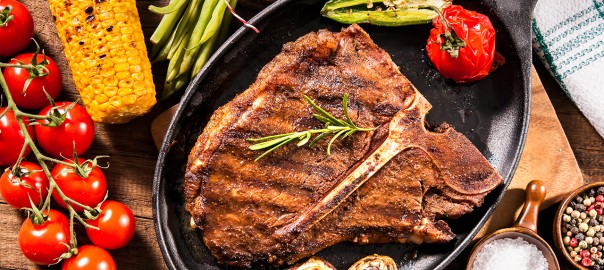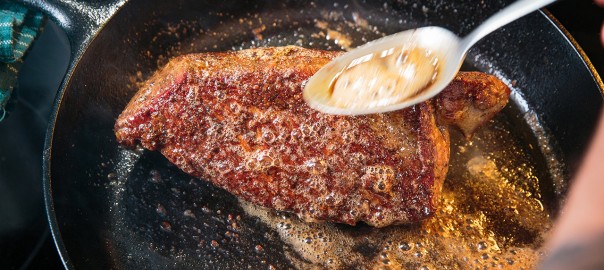You’re putting together tonight’s dinner menu and want to make sure you are using the best cut of steak. Where do you start? Does a higher price point mean higher quality? Is bone-in better than boneless? Below, you’ll find out how to navigate the meat counter to select the perfect cut for your evening.
As far as price point is concerned, a premium steak is usually priced higher because of the (relative) scarcity of the muscle that the steak is cut from. Take filet mignon, for example — arguably one of the most expensive cuts available. Filet mignon is cut from the smallest end of the tenderloin, one of the smallest — and most tender — muscles in the cow.
Most premium cuts come from the ribs (rib-eyes, Denver steak), short loin (New York strip, T-bone), sirloin (top sirloin) and tenderloin (filet mignon). Each muscle has a different fat profile, which affects the steak’s flavor, marbling and tenderness.
So which to choose?
Filet Mignon
What is it known for?
If tonight’s plans include your backyard and an open flame, our first choice is the filet mignon. This boneless, lean cut has very little connective tissue and is known for its rich, buttery flavor.
How should you prepare it?
Although the filet is a thicker cut of steak, it needs to only cook a few minutes per side to reach the perfect medium-rare temperature. We recommend cooking it over direct heat (right over the flame) for just 2-3 minutes per side, then moving your filets to a cooler portion of the grill for an additional four minutes to finish cooking without the risk of overcooking. You can find detailed grilling instructions here.
When it is time to serve your filet, it is best paired with a mushroom or wine sauce.
New York Strip
What is it known for?
On par with filet mignon, the New York strip (also known as the Kansas City strip) is another preferred grilling steak. A favorite amongst steakhouses, this is one of the most flavorful steaks you can buy.
Cut from the short loin, this steak has a higher fat content — and more marbling — than filet mignon. The name actually stems from the act of “stripping,” a knife skill used to slice individual steaks away from a large muscle (the short loin).
How should you prepare it?
A perfectly-grilled NY strip only needs a little salt and pepper, or you can top it with a dollop of garlic butter.
Rib-Eye
What is it known for?
Alright, you’re planning a date night for two and the entire meal consists of steak and potatoes. No problem! If you need a steak that holds its own, we suggest going with a rib-eye. Rib-eyes are highly marbled, which gives the steak the majority of its flavor (Prime beef, viewed as the highest-quality grade, is known for its abundant marbling).
How should you prepare it?
A rib-eye steak comes from the same muscle as a standing rib — a.k.a. prime rib — roast. You can think of a rib-eye as a standing rib roast that has been cut into individual steaks. This juicy steak has a robust flavor and heavy marbling throughout. Typically, it’s so flavorful you won’t need to add much, if anything, to it — except perhaps a scoop of ghee or a few garlic cloves.
To make it a meal, serve it with sides that live up to the steak’s heartiness. Try potatoes and mushrooms or roasted vegetables.
Porterhouse
What is it known for?
Known as “king of the T-bones,” the porterhouse is part tenderloin, part New York strip. While there’s often quite a bit of confusion around these two steaks, the USDA requires the tenderloin portion of the T-bone be at least 1.5 inches thick to be classified as a porterhouse.
How should you prepare it?
Since you’re essentially getting two steaks in one, this steak can be tricky to cook. If possible, try splitting your heat source into a hot and cool portion to prevent overcooking the tenderloin. This works best on a gas grill, where you have more control over the heat. Light burners on one half of your grill to high heat, and the burners on the other side to low heat (or completely off). Then place your porterhouse in the center.
Tri-Tip
What is it known for?
Cut from the sirloin, the tri-tip was once a rarity amongst butchers. The tri-tip comes from central California, where it was a regular item at the meat counter. However, it was relatively unheard of across the rest of the country before online ordering became more mainstream. While we love serving it as a roast, you can also cut and prepare it as individual steaks.
How should you prepare it?
The once-overlooked tri-tip is quickly gaining popularity, becoming known as one of the most underrated and delicious cuts of steak. And for the price point, you can’t beat the flavor. It’s boneless, juicy, and has excellent marbling. Simply season with a little salt, pepper, and garlic, then sear to perfection.
Bavette Steak
What is it known for?
Also known as the flap steak, the bavette steak comes from the sirloin — right next to the porterhouse. This was a fairly unknown steak a few years ago but has recently become a featured menu item at restaurants and bistros.
How should you prepare it?
Like a hanger or skirt steak, the bavette is a thin cut with a distinct grain. You’ll need to cook this steak hot and fast to avoid letting it dry out. Allow it to marinade the night before, then sear it to a perfect medium-rare.
Ranch Steak
What is it known for?
Cut from the shoulder muscle, a ranch steak is one of the leanest steaks you can buy. Boneless and usually trimmed of all fat, consider using a marinade to give it a nice, juicy flavor —and to prevent it from drying out.
How should you prepare it?
Steak salads are one of our go-tos when we’re craving something light, and the ranch steak makes the perfect cut.
Other Cuts for Steak Night
While popular cuts like filet mignon, rib-eyes, and New York strips get all the glory, there truly is a perfect steak for every occasion. Different cuts provide different benefits, and selecting a lesser-known steak might cut down on cost without sacrificing flavor. You should also consider your entire menu, including wine pairings, to determine which cut should sit center stage.
Planning your next taco Tuesday? There are multiple cuts that work well for tacos or fajitas. Anything that slices thinly — such as a skirt steak or flat iron steak — will do the trick.
Hosting a huge party? The flank steak is the best cut for serving large groups of people. This large cut is typically not broken down into smaller portions, making it perfect for feeding large crowds.
Finally, there are many cuts that complement the perfect, steakhouse-worthy menu but are more appropriate to the weeknight dinner budget than a filet or porterhouse steak. A top sirloin steak is an extremely versatile cut and tastes great when grilled or seared in a cast iron skillet. Another choice is the Denver steak, which, although lesser-known, is cut from the same muscle as a rib-eye.
Selecting the Best Cut of Steak
When selecting a steak at the grocery store or when ordering at a restaurant, sourcing will always impact the quality. Regardless of cut, choose grass-fed steaks from a trusted butcher or by ordering online. The meat will have less fat than steaks coming from a grain-fed animal, as well as more omega-3s, CLA, and a higher portion of B and E vitamins.
When cooking a grass-fed steak, there are a few things to keep in mind. First, a grass-fed steak will cook 30 percent faster than a grain-fed steak of the same cut, so don’t take your eyes off your dinner! Second, a thermometer will help prevent overcooking. A medium-rare steak will reach an internal temperature of 125°F as it rests after being removed from the heat, so it’s best to stop cooking at 115°F.
The best cut of steak starts with choosing the best cut for your complete menu. If you ever need ideas, be sure to check out our recipe page.














